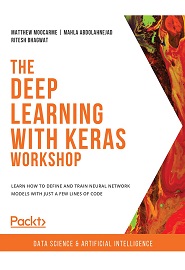
English | 2020 | ISBN: 978-1800562967 | 104 Pages | PDF, EPUB | 256 MB
Discover how to leverage Keras, the powerful and easy-to-use open-source Python library for developing and evaluating deep learning models
New experiences can be intimidating, but not this one! This beginner’s guide to deep learning is here to help you explore deep learning from scratch with Keras, and be on your way to training your first ever neural networks.
What sets Keras apart from other deep learning frameworks is its simplicity. With over two hundred thousand users, Keras has a stronger adoption in industry and the research community than any other deep learning framework.
This workshop starts by introducing you to the fundamental concepts of machine learning using the scikit-learn package. After learning how to perform the linear transformations that are necessary for building neural networks, you’ll build your first neural network with the Keras library. As you advance, you’ll learn how to build multi-layer neural networks and recognize when your model is underfitting or overfitting to the training data. With the help of interactive exercises, you’ll learn to use cross-validation techniques to evaluate your models and then choose the optimal hyperparameters to fine-tune their performance. Finally, you’ll explore recurrent neural networks and learn how to train them to predict values in sequential data.
By the end of this book, you’ll have developed the skills you need to confidently train neural network models.
What you will learn
- Gain insights into the fundamentals of neural networks
- Understand the limitations of machine learning and how it differs from deep learning
- Build image classifiers with convolutional neural networks
- Evaluate, tweak, and improve your models with techniques such as cross-validation
- Create prediction models to detect data patterns and make predictions
- Improve model accuracy with L1, L2, and dropout regularization
Resolve the captcha to access the links!